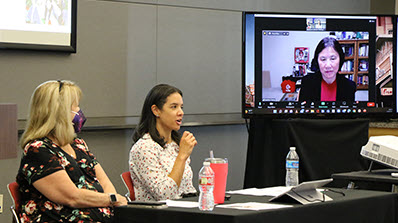RaJah Mena is part of an exclusive group, but she doesn’t want to be.
As one of the few radiation health physicists in Nevada, whose work with the Nevada National Security Site (NNSS) has helped to keep communities safe from radiological emergencies, Mena knows firsthand how important it is for the gap in her field to be filled.
“We are in dire need – cross agency, cross country,” Mena told attendees at a Women in Science panel hosted by the National Atomic Testing Museum last month. “If something bad happens, whether there’s radiological material that goes missing, or we think about the worst-case, that something actually happens, someone has to respond.”
Mena shared her experience as a manager of NNSS Consequence Management – and her team’s response to the Woolsey fire in California in 2018 – to inspire young women to consider careers in science. She was joined on the panel by Jill Hruby, Under Secretary for Nuclear Security and Administrator of the National Nuclear Security Administration (NNSA), and Dr. Baolin Cheng, Los Alamos National Laboratory Senior Weapon Physicist. Each panelist spoke about their critical work in securing the safety of the United States and its allies, and participated in a discussion led by moderator Laura Tomlinson, Deputy Manager of the NNSA’s Nevada Field Office.
“Members of our team across the enterprise do everything from atmospheric modeling, to collecting samples, and ultimately relating those things back some sort of a decision that people have to make, because that’s the goal,” Mena said. “The goal is that you have a governor who yesterday only knew floods, fires and hurricanes, and now they have to sleep at night knowing that they made decisions on radiation impacts they never heard of.”
Mena shared how her team was able to provide critical information and allay any fears to the state of California and government leaders when the Woolsey fire began to encroach on a now-defunct field laboratory that used to process radiological material.
“People were super concerned, reasonably, that maybe if the fire encroached on that land, that maybe some of that material that’s in the soil, in the trees, and buildings, could be caught up in the fire and maybe even in the atmosphere,” Mena said, adding that the NNSS has the largest share of on-call responders who are able to do this type of work.
Ultimately, their scientific analysis showed California emergency officials that there wasn’t a concern for public health or safety.
“The point of what we’re doing is making sure that we’re answering all the questions, and making sure people are safe,” she said.
The female students in attendance are starting their careers similar to how Mena did. A local Las Vegas resident, and a graduate of the University of Nevada, Las Vegas, Mena wanted to spark the same excitement she had at the beginning of her career.
She encouraged the young women to apply for internships, enroll in electives and join extracurricular groups.
“Take advantage of internships,” Mena said. “Do all of them. Expand your horizons – take all of the electives you possibly can. And my fellow nerds: talk to people!”

